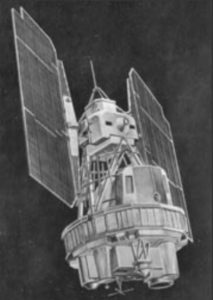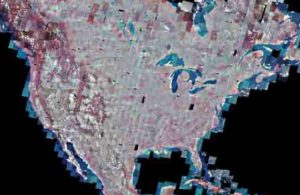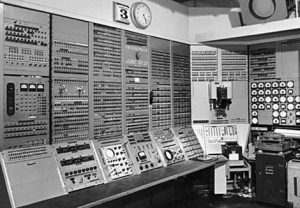sputnik
 After the Soviet Union launched Sputnik, the world’s first satellite, on October 4, 1957, inspiring the United States to keep up, or fall behind in the Cold War, the United States launched it’s first satellite on January 31, 1958. That satellite was called Explorer 1, and followed the first two Soviet satellites the previous year…Sputnik 1 and 2. It was the beginning the Cold War Space Race between the two nations. Explorer 1 had mercury batteries that powered the high-power transmitter for 31 days and the low-power transmitter for 105 days. Explorer 1 stopped transmission of data on May 23, 1958 when its batteries died, but remained in orbit for more than 12 years. It reentered the atmosphere over the Pacific Ocean on March 31, 1970 after more than 58,000 orbits. The Explorer 1 payload consisted of the Iowa Cosmic Ray Instrument. It was without a tape data recorder, which was not modified in time to make it onto the spacecraft. The real-time data received on the ground was therefore very sparse and puzzling showing normal counting rates and no counts at all. I’m not sure what the counting was all about, so I guess I’m more confused than the scientists were. The later Explorer 3 mission, which included a tape data recorder in the payload, provided the additional data for confirmation of the earlier Explorer 1 data.
After the Soviet Union launched Sputnik, the world’s first satellite, on October 4, 1957, inspiring the United States to keep up, or fall behind in the Cold War, the United States launched it’s first satellite on January 31, 1958. That satellite was called Explorer 1, and followed the first two Soviet satellites the previous year…Sputnik 1 and 2. It was the beginning the Cold War Space Race between the two nations. Explorer 1 had mercury batteries that powered the high-power transmitter for 31 days and the low-power transmitter for 105 days. Explorer 1 stopped transmission of data on May 23, 1958 when its batteries died, but remained in orbit for more than 12 years. It reentered the atmosphere over the Pacific Ocean on March 31, 1970 after more than 58,000 orbits. The Explorer 1 payload consisted of the Iowa Cosmic Ray Instrument. It was without a tape data recorder, which was not modified in time to make it onto the spacecraft. The real-time data received on the ground was therefore very sparse and puzzling showing normal counting rates and no counts at all. I’m not sure what the counting was all about, so I guess I’m more confused than the scientists were. The later Explorer 3 mission, which included a tape data recorder in the payload, provided the additional data for confirmation of the earlier Explorer 1 data.
Landsat 1, which was originally named “Earth Resources Technology Satellite 1”, was the first satellite in the United States’ Landsat program. It was the first satellite that was launched with the sole purpose of studying and monitoring the planet. Landsat 1 was a modified version of the Nimbus 4 meteorological satellite and was launched on July 23, 1972 by a Delta 900 rocket from Vandenberg Air Force Base in California. Its orbit was near-polar and it served as a stabilized, Earth-oriented platform for obtaining information on agricultural and forestry resources, geology and mineral resources, hydrology and water resources, geography, cartography, environmental pollution, oceanography and marine resources, and meteorological phenomena. The spacecraft was placed in a sun-synchronous orbit, with an altitude between 564 and 569 miles. The spacecraft was placed in an orbit with an inclination of 99 degrees which orbited the Earth every 103 minutes. The project was renamed to Landsat in 1975.
Landsat 1 had two sensors to achieve its primary objectives…the return beam Vidicon (RBV) and the multispectral scanner (MSS). The RBV was manufactured by the Radio Corporation of America (RCA). The RBV obtained visible light and near infrared photographic images of Earth. It was considered the primary sensor. The MSS sensor manufactured by Hughes Aircraft Company was considered an experimental and secondary sensor, until scientists reviewed the data that was beamed back to Earth. After the data was reviewed, the MSS  was considered the primary sensor. The MSS was a four-channel scanner that obtained radiometric images of Earth. From launch until 1974, Landsat 1 transmitted over 100,000 images, which covered more than 75% of the Earth’s surface. The RBV only took 1690 images. In 1976, Landsat 1 discovered a tiny uninhabited island 12 miles off the eastern coast of Canada. This island was named Landsat Island after the satellite. The MSS provided more than 300,000 images over the lifespan of the satellite. NASA oversaw 300 researchers that evaluated the data that Landsat 1 transmitted back to Earth. The Landsat 1 satellite sent data back to earth from its orbit until January of 1978 when its tape recorders malfunctioned. After that, it was taken out of service.
was considered the primary sensor. The MSS was a four-channel scanner that obtained radiometric images of Earth. From launch until 1974, Landsat 1 transmitted over 100,000 images, which covered more than 75% of the Earth’s surface. The RBV only took 1690 images. In 1976, Landsat 1 discovered a tiny uninhabited island 12 miles off the eastern coast of Canada. This island was named Landsat Island after the satellite. The MSS provided more than 300,000 images over the lifespan of the satellite. NASA oversaw 300 researchers that evaluated the data that Landsat 1 transmitted back to Earth. The Landsat 1 satellite sent data back to earth from its orbit until January of 1978 when its tape recorders malfunctioned. After that, it was taken out of service.
 These days, being connected to the internet is commonplace. We connect from our computer, laptop, tablet, and even our phone. Many occupations, including the one I am in could not really function without the internet. When the computers go down, we are shut down too. For most of us, the internet is so much a part of our lives, that we simply cannot imagine life without it. Nevertheless, the reality is that until quite recently, there was no internet. I know people who think that might have been a better time, but I disagree. In fact, I think the people who say they think that, really have no idea just how bad that would be, and if they tried it once, they would change their minds quickly. People don’t realize how many things depend on the internet.
These days, being connected to the internet is commonplace. We connect from our computer, laptop, tablet, and even our phone. Many occupations, including the one I am in could not really function without the internet. When the computers go down, we are shut down too. For most of us, the internet is so much a part of our lives, that we simply cannot imagine life without it. Nevertheless, the reality is that until quite recently, there was no internet. I know people who think that might have been a better time, but I disagree. In fact, I think the people who say they think that, really have no idea just how bad that would be, and if they tried it once, they would change their minds quickly. People don’t realize how many things depend on the internet.
The first real idea of information available at our fingertips began to form on October 4, 1957, when the Soviet Union launched the world’s first manmade satellite into orbit. Known as Sputnik, the satellite did not do much. It tumbled aimlessly around in outer space, sending blips and bleeps from its radio transmitters as it circled the Earth. Nevertheless, to many Americans, the one foot diameter Sputnik was proof of something alarming. Up to this point, scientists and engineers in the United States had been designing bigger cars and better television sets, but the Soviets had been focusing on…less frivolous things, and they were going to win the Cold War because of it. Americans saw that information could eventually be transmitted back to the Soviets concerning American military and government secrets. It was the dawning of the age of spy satellites.
Sputnik’s launch, brought about the era of science and technology in America. In an effort to keep up, schools began teaching subjects like chemistry, physics and calculus. The government gave grants to corporations, who invested them in scientific research and development. The federal government formed new agencies, such as the National Aeronautics and Space Administration (NASA) and the Department of Defense’s Advanced Research Projects Agency (ARPA), to develop space-age technologies such as rockets, weapons and computers. Of course, the computer didn’t do nearly as much as it does these days, and it was the size of a small house. In 1962, a scientist from M.I.T. and ARPA named J.C.R. Licklider proposed a solution to this problem. His proposal  was a “galactic network” of computers that could talk to one another. Such a network would enable government leaders to communicate even if the Soviets destroyed the telephone system. Then came “packet switching.” Packet switching breaks data down into blocks, or packets, before sending it to its destination. That way, each packet can take its own route from place to place. Without packet switching, the government’s computer network, which is now known as the ARPAnet, would have been just as vulnerable to enemy attacks as the phone system. At least now computers did more, but they were still big.
was a “galactic network” of computers that could talk to one another. Such a network would enable government leaders to communicate even if the Soviets destroyed the telephone system. Then came “packet switching.” Packet switching breaks data down into blocks, or packets, before sending it to its destination. That way, each packet can take its own route from place to place. Without packet switching, the government’s computer network, which is now known as the ARPAnet, would have been just as vulnerable to enemy attacks as the phone system. At least now computers did more, but they were still big.
In 1969, ARPAnet delivered its first message. A “node-to-node” communication from one computer located in a research lab at UCLA, to the second located at Stanford. The message “LOGIN” was short and simple, and it crashed the ARPA network. Wow!! Things really are different today. The Stanford computer only received the note’s first two letters. By the end of 1969, just four computers were connected to the Arpanet. During the 1970s the network grew steadily. In 1971, it added the University of Hawaii’s ALOHAnet, and two years later it added networks at London’s University College and the Royal Radar Establishment in Norway. As packet-switched computer networks multiplied, it became more difficult for them to integrate into a single worldwide “Internet.” By the end of the 1970s, a computer scientist named Vinton Cerf had begun to solve this problem by developing a way for all of the computers on all of the world’s mini-networks to communicate with one another. He called his invention “Transmission Control Protocol,” or TCP. Later, he added an additional protocol, known as “Internet Protocol.” The acronym we use to refer to these today is TCP/IP. One writer describes Cerf’s protocol as “the ‘handshake’ that introduces distant and different computers to each other in a virtual space.”
Cerf’s protocol transformed the Internet into a worldwide network. Throughout the 1980s, researchers and scientists used it to send files and data from one computer to another. In 1991 the Internet changed again. That year, a computer programmer in Switzerland named Tim Berners-Lee introduced the World Wide Web…an Internet that was not simply a way to send files from one place to another, but was itself a “web” of information that anyone on the Internet could retrieve. Berners-Lee created the Internet that we know and use today. Since then, the Internet has changed in many ways, and will likely continue to change as time goes on.  In 1992, a group of students and researchers at the University of Illinois developed a browser that they called Mosaic, later known as Netscape. Mosaic offered a user-friendly way to search the Web. It allowed users to see words and pictures on the same page for the first time and to navigate using scrollbars and clickable links. Then Congress decided that the Web could be used for commercial purposes. Companies developed websites of their own, and e-commerce entrepreneurs began to use the Internet to sell goods directly to customers. These days, social networking sites like Facebook have become a popular way for people of all ages, including me, to stay connected. Today, almost one-third of the world’s 6.8 billion people use the Internet regularly.
In 1992, a group of students and researchers at the University of Illinois developed a browser that they called Mosaic, later known as Netscape. Mosaic offered a user-friendly way to search the Web. It allowed users to see words and pictures on the same page for the first time and to navigate using scrollbars and clickable links. Then Congress decided that the Web could be used for commercial purposes. Companies developed websites of their own, and e-commerce entrepreneurs began to use the Internet to sell goods directly to customers. These days, social networking sites like Facebook have become a popular way for people of all ages, including me, to stay connected. Today, almost one-third of the world’s 6.8 billion people use the Internet regularly.

